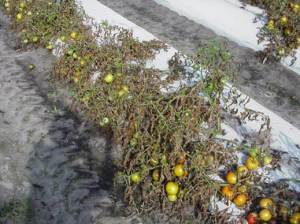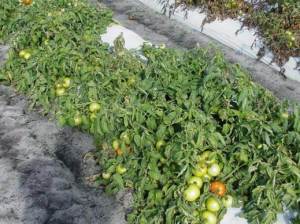The late blight fungus attacks all aboveground parts of the tomato plant. Infected foliage becomes brown, shrivels and soon dies. When severe, all plants in a field may be killed in a week or two. The spores can be disseminated up to 30 or 40 miles by wind or over short distances by dew and rain. Each spore may swim in a film of water on plant surfaces to initiate a new infection. A recent article summarizes the effects of a severe late blight outbreak in the U. S…
“Indeed, the tomato late blight pandemic of 2009 made late blight into a household term in much of eastern USA. Many home gardeners and many organic producers lost most, if not all, of their tomato crop. Some CSAs (Community Supported Agriculture) could not provide tomatoes to their members. …This pandemic was unusual. It started synchronously in mid to late June over much of the northeastern USA. The pathway was via infected tomato transplants shipped to the garden centers in large retail stores throughout the Northeast. …Many homeowners and organic growers lost crops when fungicide was not applied soon enough, and because they lacked highly effective curative fungicide options. (Conventional commercial growers, who have more fungicide options, were more successful in delaying the epidemic and subsequent yield loss.) …Later in the year other issues arose. Consumers were alarmed to see fungicide residues on tomatoes at farmers markets, especially on organically produced fruit. (Some copper-based fungicides are allowed in organic production in some states.)”
Authors: W. E. Fry, et al.
Affiliations: Cornell University
Title: The 2009 Late Blight Pandemic in Eastern USA.
Publication: APSnet Features. 2012. http://www.apsnet.org/publications/apsnetfeatures/Pages/2009LateBlight.aspx


